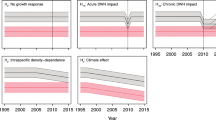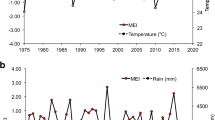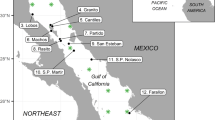Abstract
Broad-scale multi-species declines in populations of North American sea ducks for unknown reasons is cause for management concern. Oceanic regime shifts have been associated with rapid changes in ecosystem structure of the North Pacific and Bering Sea. However, relatively little is known about potential effects of these changes in oceanic conditions on marine bird populations at broad scales. I examined changes in North American breeding populations of sea ducks from 1957 to 2011 in relation to potential oceanic regime shifts in the North Pacific in 1977, 1989, and 1998. There was strong support for population-level effects of regime shifts in 1977 and 1989, but little support for an effect of the 1998 shift. The continental-level effects of these regime shifts differed across species groups and time. Based on patterns of sea duck population dynamics associated with regime shifts, it is unclear if the mechanism of change relates to survival or reproduction. Results of this analysis support the hypothesis that population size and trends of North American sea ducks are strongly influenced by oceanic conditions. The perceived population declines appear to have halted >20 years ago, and populations have been relatively stable or increasing since that time. Given these results, we should reasonably expect dramatic changes in sea duck population status and trends with future oceanic regime shifts.


Similar content being viewed by others
References
Agler BA, Kendall SJ, Irons DB, Klosiewski SP (1999) Declines in marine bird populations in Prince William Sound, Alaska coincident with a climatic regime shift. Waterbirds 22:98–103
Alisauskas RT, Ankney CD (1992) Egg laying and nutrient reserves. In: Batt BJD, Afton AD, Anderson MG, Ankney CD, Johnson DH, Kadlec JA, Krapu GL (eds) Ecology and management of breeding waterfowl. University of Minnesota Press, Minneapolis, pp 30–61
Alisauskas RT, Traylor JJ, Swoboda CJ, Kehoe FP (2004) Components of population growth rate for white-winged scoters in Saskatchewan, Canada. Anim Biodivers and Conserv 27:451–460
Baylis AMM, Zuur AF, Brickle P, Pistorius PA (2012) Climate as a driver of population variability in breeding gentoo penguins Pygoscelis papua at the Falkland Islands. Ibis 154:30–41
Beaugrand G (2004) The North Sea regime shift: evidence, causes, mechanisms and consequences. Prog Oceanogr 60:245–262
Bellrose FC (1980) Ducks, geese and swans of North America. Wildlife Management Institute, Washington, DC
Benson AJ, Trites AW (2002) Ecological effects of regime shifts in the Bering Sea and eastern North Pacific Ocean. Fish Fish 3:95–113
Bentzen RL, Powell AN (2012) Population dynamics of king eiders breeding in northern Alaska. J Wild Manage 76:1011–1020
Burnham KP, Anderson DR (2002) Model selection and multimodel inference: a practical information-theoretic approach, 2nd edn. Springer, New York
Camphuysen CJ, Berrevoets CM, Cremers HJWM, Dekinga A, Dekker R, Ens BJ, van der Have TM, Kats RKH, Kuiken T, Leopold MF, van der Meer J, Piersma T (2002) Mass mortality of common eiders (Somateria mollissima) in the Dutch Wadden Sea, winter 1999/2000: starvation in a commercially exploited wetland of international importance. Biol Conserv 106:303–317
Coulson JC (2010) A long-term study of the population dynamics of common eiders Somateria mollissima: why do several parameters fluctuate markedly? Bird Study 57:1–18
Descamps S, Yoccoz NG, Gaillard J-M, Gilchrist HG, Erikstad K, Hanssen SA, Cazelles B, Forbes MR, Bêty J (2010) Detecting population heterogeneity in effects of North Atlantic Oscillations on seabird body condition: get into the rhythm. Oikos 119:1526–1536
deYoung B, Barange M, Beaugrand G, Harris R, Perry RI, Scheffer M, Werner F (2008) Regime shifts in marine ecosystems: detection, prediction and management. Trends Ecol Evol 23:402–409
Drever MC, Clark RG, Derksen C, Slattery SM, Toose P, Nudds TD (2012) Population vulnerability to climate change linked to timing of breeding in boreal ducks. Global Change Biol 18:480–492
Gilliland SG, Gilchrist HG, Rockwell RF, Robertson GJ, Savard J-PL, Merkel F, Mosbech A (2009) Evaluating the sustainability of harvest among northern common eiders Somateria mollissima borealis in Greenland and Canada. Wildl Biol 15:24–36
Hare SR, Mantua NJ (2000) Empirical evidence for North Pacific regime shifts in 1977 and 1989. Prog Oceanogr 47:103–145
Hario M, Rintala J (2006) Fledgling production and population trends in Finnish common eiders Somateria mollissima- evidence of density dependence. Can J Zool 84:1038–1046
Hario M, Mazerolle MJ, Saurola P (2009) Survival of female common eiders Somateria m. mollissima in a declining population in the northern Baltic Sea. Oecologia 159:747–756
Hodges JI, King JG, Conant B, Hanson HA (1996) Aerial surveys of waterbirds in Alaska 1957–94: population trends and observer variability. Natl Biol Serv Inf Technol Rep 4:1–24
Irons DB, Anker-Nilssen T, Gaston AJ, Byrd GV, Falk K, Gilchrist G, Harrio M, Hjernquist M, Krasnov YV, Mosbech A, Olsen B, Petersen A, Reid JB, Robertson GJ, Strom H, Wohl KD (2008) Fluctuations in circumpolar seabird populations linked to climate oscillations. Global Change Biol 14:1455–1463
Jones IL, Hunter FM, Robertson GJ (2002) Annual adult survival of least auklets (Aves, Alcidae) varies with large-scale climatic conditions of the North Pacific Ocean. Oecologia 133:38–44
Korschgen CE (1977) Breeding stress of female eiders in Maine. J Wild Manage 41:360–373
Lees K, Pitois S, Scott C, Frid C, Mackinson S (2006) Characterizing regime shifts in the marine environment. Fish Fish 7:104–127
Lehikoinen A, Kilpi M, Öst M (2006) Winter climate affects subsequent breeding success of common eiders. Global Change Biol 12:1355–1365
Mantua NJ, Hare SR, Zhang Y, Wallace JM, Francis RC (1997) A Pacific interdecadal climate oscillation with impacts on salmon production. Bull Am Meterol Soc 78:1069–1079
Minobe S (1997) A 50–70 year climatic oscillation of the North Pacific and North America. Geophys Res Lett 24:683–686
Overland J, Rodionov S, Minobe S, Bond N (2008) North Pacific regime shifts: definitions, issues, and recent transitions. Prog Oceanogr 77:92–102
Petersen MR, Douglas DC (2004) Winter ecology of spectacled eiders: environmental characteristics and population change. Condor 106:79–94
Reynolds TJ, Harris MP, King R, Swann RL, Jardine DC, Frederiksen M, Wanless S (2011) Among-colony synchrony in the survival of common guillemots Uria aalge reflects shared wintering areas. Ibis 153:818–831
Robertson GJ, Gilchrist HG (1998) Evidence of population declines among common eiders breeding in the Belcher Islands, Northwest Territories. Arctic 51:378–385
Rudnick DL, Davis RE (2003) Red noise and regime shifts. Deep-Sea Res I 50:691–699
Sandvik N, Erikstad KE, Barrett RT, Yoccoz NG (2005) The effect of climate on adult survival in five species of North Atlantic seabirds. J Anim Ecol 74:817–831
Schamber JL, Flint PL, Grand JB, Wilson HM, Morse JA (2009) Population dynamics of long-tailed ducks breeding on the Yukon-Kuskokwim Delta, Alaska. Arctic 62:190–200
Sea Duck Joint Venture (2003) Species status report. http://www.seaduckjv.org/meetseaduck/species_status_summary.pdf. Accessed 9 August 2012
Smith GW (1995) A critical review of the aerial and ground surveys of breeding waterfowl in North America. Biol Sci Rep 5, Natl Biol Serv, Washington, DC, p 252
Spencer M, Mieszkowska N, Robinson LA, Simpson SD, Burrows MT, Birchenough SNR, Capasso E, Cleall-Harding P, Crummy J, Duck C, Eloire D, Frost M, Hall AJ, Hawkins SJ, Johns DG, Sims DW, Smyth TJ, Frid CLJ (2012) Region-wide changes in marine ecosystem dynamics: state-space models to distinguish trends from step changes. Global Change Biol 18:1270–1281
Vandenbosch R (2000) Effects of ENSO and PDO events on seabird populations as revealed by Christmas bird count data. Waterbirds 23:416–422
Zipkin EF, Gardner B, Gilbert AT, O’Connell AF, Royle JA, Silverman ED (2010) Distribution patterns of wintering sea ducks in relation to the North Atlantic Oscillation and local environmental characteristics. Oecologia 163:893–902
Acknowledgments
Credit for these data goes to the dedicated biologists of the US Fish and Wildlife Service and Canadian Wildlife Service that have maintained this long-term survey. D. Derksen, J. Pearce, M. Petersen and E. Silverman provided comments on an earlier draft.
Conflict of interest
The author declares no conflict of interest. Any use of trade names is for descriptive purposes only and does not imply endorsement by the US Government.
Author information
Authors and Affiliations
Corresponding author
Additional information
Communicated by S. Garthe.
Rights and permissions
About this article
Cite this article
Flint, P.L. Changes in size and trends of North American sea duck populations associated with North Pacific oceanic regime shifts. Mar Biol 160, 59–65 (2013). https://doi.org/10.1007/s00227-012-2062-y
Received:
Accepted:
Published:
Issue Date:
DOI: https://doi.org/10.1007/s00227-012-2062-y




